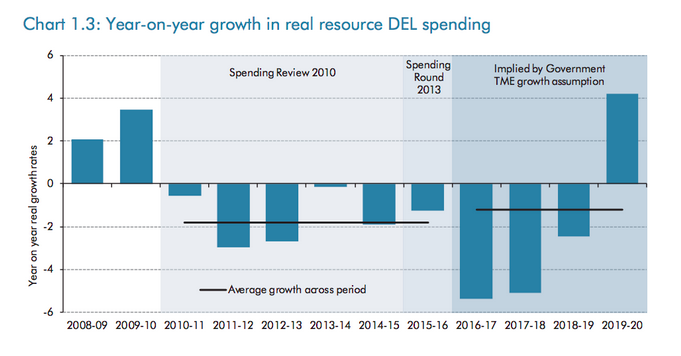
Read this piece on our election site, May2015.com.
“Sun shines on savers”, “UK booming…Jobs at record high”, “The comeback king”, “End of tax on savings”. The four papers likely to back the Tories in May – the Mail, the Sun, the Times and the Telegraph – have delivered their verdict on the Budget, and they paint a pleasant picture.
But the headlines hide the most important, and least reassuring, fact in yesterday’s Budget: to eliminate the deficit, Osborne is going to cut spending more severely in the next two years than the coalition has in any year so far.
Here’s the key graph. It’s as trustworthy as they come. It was made by the Office for Budget Responsibility – an independent body that exists to analyse the public finances.
The Tories are planning to cut spending by 5.1 per cent in 2016-17 and 4.6 per cent in 2017-18. That’s greater than in any year since austerity began in 2010, and nearly twice as much as the average cut over the past five years (2.8 per cent).
The cuts scheduled for next year are more than four times greater than the cuts Britain is facing over the next twelve months.
Next year’s cuts will be four times greater than those Britain is facing this year.
After two years of deep cuts (2016-17 and 2017-18), Osborne plans to return to this year’s more moderate levels of austerity in 2018-19, before increasing spending dramatically in 2019-20 (by 4.3 per cent). [1]
This is purely political. By cutting spending sharply at first, Osborne can deliver a final dose of medicine and then suddenly start spending just before the 2020 election.
There is no economic basis for this. As the FT put it, an “ever more annoyed” Robert Chote, chair of the OBR, tersely described Osborne’s plan as a “rollercoaster”. The Times, in contrast to their front-page, concurred, with a double page spread on how “Experts warn of a rollercoaster ride in row over public spending”.
Instead of this “bonkers” approach (the Guardian’s Patrick Wintour), Osborne could balance the cuts across all four years. The austerity in each year would be lower than the average over the past five years, and far more manageable for the services set to be slashed.
Government spending isn’t abstract. Osborne can’t just take a few pennies of one year, add them back in the next, and easily replace the services he’s crippled.
[1] These figures are on p.129 of the report.







